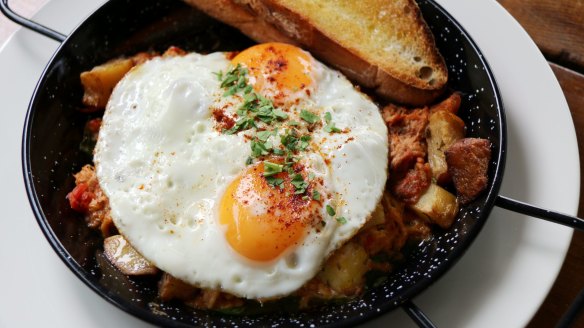How to make the perfect fried egg

I like my fried eggs runny but not too runny. E. Kidd
Put a lid on it. Literally. Frying delivers heat from the bottom of the pan and the fat stops the eggs from sticking while adding flavour.
Placing a stainless steel lid over the eggs as they fry will reflect heat back down onto the eggs, trapping hot air and thus cooking them from above.
What is kefir? L. Rundell.
Kefir is an ancient way of preserving milk by lactic fermentation. It has the colour of milk but the viscosity of a thick shake – without the diabetes-inducing levels of sugar. It has the lovely dairy aroma of milk with the pleasant scent of fresh yoghurt.
Although slightly viscous, it has a clean mouth feel and finishes with a tang. It has a length of flavour of the lightest curd cheese and a pleasing savoury sensation. When it hits the stomach it doesn't have the heaviness of having consumed milk, let alone the gut regret that can come from a thick shake.
To make kefir, pasteurised milk is fermented with cultures that create lactic acid, forming the protein into a curd that traps the liquid and nutrients.
The fat separates and floats to the top, so when kefir is bottled it forms a natural stopper protecting the kefir from the air – so store kefir upright in the fridge. Because it is acidic, it can be used in recipes where cultured buttermilk is called for. The lactic acid activates baking soda making for fluffy pancakes. It is perfect blended with ice and fruit – and perhaps a little honey – to make a delicious smoothie.
Because it has a subtle savoury flavour, kefir makes superb dressings; fold through some olive oil, salt and a little garlic and use to dress a salad or pour over barbecue lamb. It is also incredibly high in probiotics.
When should I add my bay leaves to a slow-cooked dish? L. Kaplan
My grandmother made a dish very popular in the late 1960s and '70s called beef olives. Thinly sliced pieces of cheap steak were stuffed with breadcrumbs and cooked in a beef stock with carrot, celery and flavoured with bay leaves.
She always taught us that it was something special to find the bay leaves in your serve. It was only years later that I learned Nana had cataracts and couldn't see the bay leaves to fish them out. Fresh bay leaves are a living chemical factory producing different aromatic compounds such as eucalyptol, terpenes, pinenes, phellandrene, linalool, geraniol, terpineol and lauric acid. Sounds like a witch's brew.
Some of these compounds are volatile and will end up floating around as a lovely aroma in the kitchen but not in your dish. If you want a lovely subtle back note, add the bay leaves earlier in the cooking process. Add them towards the end of cooking, and the flavour will be more potent but will bring a discordant note to the dish. This isn't necessarily a bad thing. You just have to the right wine to serve with the dish.
Send your vexing culinary conundrums to brainfood@richardcornish.com.au or tweet to @Foodcornish.
Appears in these collections
The best recipes from Australia's leading chefs straight to your inbox.
Sign up- More:
- How to
